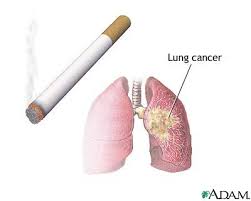 Cigarette Smoking Overview
Cigarette Smoking OverviewCigarette smoking remains a leading contributor to death and illness among Americans. Every year, roughly 440,000 Americans die from illnesses caused by tobacco use, accounting for nearly one-fifth of all deaths. Tobacco use costs the nation about $100 billion each year in direct medical expenses and in lost productivity for a total cost of about 200 billion per year as estimated by the CDC.
About 23% of all American adults (46.2 million people) smoke. This number has remained constant for several years despite government efforts through Healthy People 2000 and Healthy People 2010 to lower those percentages. Slightly more men (28.1%) smoke than women (23.5%). Hispanics (16.7%) and Asian Americans (12.4%) smoke less than whites (24.0%) or African Americans (22.3%). In younger age groups, almost 27% of those 18 to 24 years old are current smokers.
Nevertheless, significant progress has been made since 1964, when the Surgeon General issued the first report outlining the health dangers of smoking. Since that time, the prevalence of smoking has dropped from 42.4% among adults to 22.8%. Lung cancer, chronic bronchitis and emphysema would become infrequently diagnosed diseases if people would stop smoking.
Compared to a nonsmoker, a smoker faces these risks:
fourteen times greater risk of dying from cancer of the lung, throat, or mouth;
four times greater risk of dying from cancer of the esophagus;
two times greater risk of dying from a heart attack;
and
two times greater risk of dying from cancer of the bladder.
Use of other tobacco products such as pipes, cigars, and snuff is less common, comprising less than 10% of use of all tobacco products; however, the health effects of these products are similar to those of tobacco - particularly their association with cancers of the mouth, throat, and esophagus.
Increasing attention has been devoted to publicizing the dangers of second-hand (environmental) smoke, the association between tobacco marketing and initiation of smoking among youth, and the development of strategies and medications to help smokers quit. According to the CDC, about 126 million people are exposed to secondhand smoke and are put at risk for tobacco-related problems such as lung cancer, heart disease and respiratory infections. In addition, a new problem termed "third-hand smoke" has been recently investigated; cigarette smoke generated carcinogens lodge in clothing, carpets, drapes and other materials and can be absorbed through human skin, especially that of children and infants. These carcinogens can also be ingested and inhaled in dust.
Cigarette smoking has been linked strongly to the following illnesses:
heart disease
stroke
hypertension (high blood pressure)
other diseases of blood vessels (such as poor circulation in the legs) and aortic aneurysms (potentially life-threatening disruptions in the wall of the aorta)
respiratory illness, including the following:
lung cancer
emphysema
bronchitis
pneumonia
cancers,
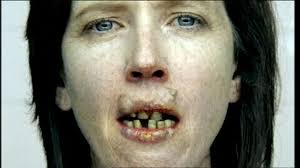
Cigarette Smoking Symptoms
Signs and symptoms of cigarette smoking are frequently obvious even to a casual observer. Besides the confirmatory evidence (a person actually smoking a cigarette in public view), nicotine-stained fingers and teeth, the characteristic smell of smoke impregnated clothing and home items, the chronic "smokers cough," the gravelly voice, and often the visible pack of cigarettes and lighter in a person's pocket or purse are signs and symptoms that a person smokes. However, new (teenage) smokers or "infrequent" smokers may exhibit few or none of these signs and symptoms.
Signs and symptoms of tobacco related diseases often depend on the specific illnesses they cause.
Shortness of breath may be a sign of emphysema or heart disease.
Chest pain may signal angina pectoris caused by insufficient blood flow to the heart or a heart attack.
Difficulty swallowing, or persistent hoarseness, may signal a cancer in the mouth or larynx.
Painless bloody urination may mean bladder cancer.
The presence of any of the following common symptoms associated with tobacco use should prompt a visit to the doctor or hospital's emergency department:
chest pain
,
shortness of breath
,
persistent cough
,
coughing up blood
,
frequent colds and upper respiratory infections,
persistent hoarseness
,
difficulty or pain on swallowing
,
change in exercise capacity
,
sudden weakness on one side of the face or body; or difficulty speaking
,
leg pain while walking that goes away when you rest
,
unexplained weight loss
,
persistent abdominal pain
, and
blood in the urine.
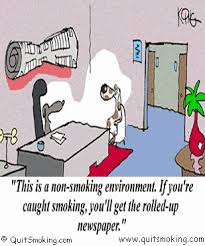
When to Seek Medical Care
If you are interested in quitting smoking, call your doctor.
It is never too early to think about quitting.
Every encounter with a doctor, whether in the office, the hospital, the emergency department, or clinic, is a good time to talk about smoking and the possibility of quitting.
Anyone, but especially smokers, with unexplained or sudden onset chest pain or difficulty breathing should go to the nearest hospital's emergency department, probably by ambulance. These conditions may be symptoms of a heart attack or other serious health problems, which can be life-threatening if not recognized and treated promptly. Tobacco use may cause problems (for example, hypertension, vascular alterations) that lead to shortness of breath or chest pain that may be life-threatening.
Tobacco use may lead or contribute to one of the following causes of dyspnea or chest pain:
pneumonia,
acute attack of emphysema,
pulmonary embolism (blood clot in the lung),
aortic aneurysm (a widening of the main artery leaving the heart, caused by a weakening in the wall of the artery), and
aortic dissection (a tearing of the wall of the aorta, which, if it ruptures, bleeds profusely).
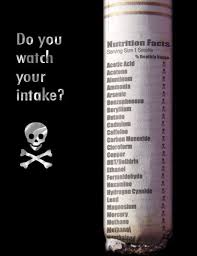
Exams and Tests
Diagnosing tobacco use or tobacco-related illness is not difficult.
Doctors should ask people about tobacco use at every visit and provide counseling about quitting.
Most people who smoke admit doing so, in part because smoking carries less social stigma than use of other substances, such as alcohol or illicit drugs. Smokers should be honest and not underestimate how much they smoke and for what length of time (for example, a pack a day since age 16), as this information helps the doctor understand the risk for tobacco-related disease.
Upon a physical exam, a doctor may find various conditions associated with chronic tobacco use.
Nicotine causes a characteristic brown staining of the hard palate, teeth, fingers, and fingernails.
A smoker's skin may wrinkle prematurely.
Smokers have a typical odor to their hair and clothing.
People with emphysema may have a large, barrel-shaped chest and a chronic cough that produces thick green sputum.
Occasionally, a smoker may have pulmonary function tests performed to help determine the amount of damage done to the lungs by smoking.
Cigarette Smoking Treatment

Medical Treatment
Treating tobacco involves helping the individual successfully stop smoking. This often requires integrated steps.
Smokers must partner with their doctors, families, spouses, friends, even employers, to make quitting successful.
Quitting is not easy. Every year, 34% of all smokers try to quit, but only about 2.5% succeed. Nonetheless, 1 million Americans quit smoking each year.
Treatment consists of two broad areas.
The medical conditions caused by smoking - respiratory illness, heart disease, circulatory disease, cancer, ulcers - need to be treated. In addition to stopping smoking, the individual's medical condition, if one is present, needs to be addressed by the patient's doctor; unfortunately there are too many conditions and treatments to be covered in this article. Smokers need to discuss individual treatments for their individual diagnosis with their primary caregiver.
The nicotine addiction also must be addressed and generally consists of a combination of the following:
Nicotine replacement therapy (gum, patch, lozenges, inhaler, or nasal spray): Some nicotine replacement products (gum, patches, and lozenges) are available over the counter, under several brand names, but are best used in conjunction with a doctor. Others (nasal sprays and inhalers) require a prescription. The non-prescription products are less expensive and work as well as the prescription products.
Varenicline (Chantix) is a prescription drug approved by the U.S. FDA to help adults quit smoking. Chantix acts on the nicotine receptors in the brain, stimulating these receptors and blocking the ability of nicotine to attach to these receptors. Chantix is taken seven days prior to the date an individual desires to quit smoking, and most people will keep taking Chantix for up to 12 weeks.
Group or behavioral counseling. The most successful quitting programs use combinations of drug treatment and counseling and have success rates of 5% after 1 year.
The prescription antidepressant bupropion (Zyban, Wellbutrin) has also been shown to help some people quit smoking.
Smokers trying to quit need lots of support and encouragement to help handle the inevitable urges to light up.
Doctors, although trained in the diagnosis and treatment of smoking-related illnesses, may be less comfortable in providing the counseling and drug treatment smokers need to quit.
Call your local chapter of the American Lung Association for further advice about smoking cessation programs.
Other Treatments
Treatment of the many diseases and conditions associated with smoking is dependent upon the extent and severity of the condition. Treatments are numerous, varied and are best done in consultation with the individual's primary care physician and associated caregivers (for example, cardiologist, oncologist). Smoking cessation products are available (see medical treatment above) for home use for people interested in quitting smoking.
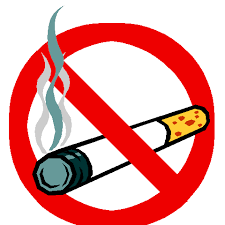
Prevention
Prevention can be easy; simply do not start to smoke cigarettes…ever. Unfortunately, quitting is often very difficult. Most smokers begin to smoke as teenagers. Every day, about 3,000 American youths start smoking and nicotine in smoke is addicting for many people. Efforts at the federal, state, and local levels to enact and enforce laws barring sales (of cigarettes) to minors need to be encouraged and enforced to minimize this addictive and potentially destructive habit.
Parents still have the biggest impact on their children's decision whether to smoke. The best way to prevent a youngster from taking up smoking likely is to have parents who don't smoke. Children from smoking households are more likely to begin smoking than children from nonsmoking households.
Much attention has been focused in recent years on the influence of tobacco company advertising on encouraging young people to smoke.
Although cigarette commercials have been banned from television for over 30 years, tobacco products remain among the most heavily marketed products. According to the American Lung Association, the tobacco industry spent an estimated $12.49 billion on advertising in 2006. Some states place restrictions on the type and locations of tobacco advertising, and legislation enacted in 2009 gave the U.S. FDA strong authority to regulate tobacco products, which is likely to have a significant impact on tobacco advertising and marketing.
Studies have shown that youth are particularly susceptible to tobacco marketing campaigns.
In the past, cigarette use by actors in popular films was a means to portray smoking as sophisticated and glamorous.
Although denied by tobacco companies, the use of cartoon animals and the like in advertising campaigns appeals to youngsters.
Counter-advertising by various antismoking advocacy groups may provide some balance, but their advertising budgets pale beside those of tobacco companies.
Schools generally provide education on the use of tobacco, alcohol, and other substances, but their impact is unclear.
Increasing the taxes on cigarettes, and hence their price, has been shown to reduce tobacco consumption, especially among adolescents.
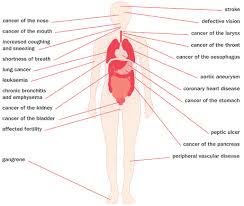
Outlook
For smokers, quality and length of life depends on the number and severity of smoking-associated illnesses they may develop and if they have other medical conditions such as diabetes or high blood pressure. Other lifestyle factors—use of alcohol or other drugs, for example—also make a difference in long-term outcomes for smokers. For smokers who quit, projected health and life expectancy improve markedly - at any age of life.
Smokers who quit before age 50 years have half the risk of dying in the next 15 years compared with those who continue to smoke.
Quitting smoking substantially decreases the risk of lung, larynx, esophageal, oral, pancreatic, bladder, and cervical cancers. For example, 10 years after quitting, an ex-smoker has 30% to 50% of the risk of lung cancer compared to a continuing smoker. Continued smoking abstinence continues to lower the risk.
Quitting lowers the risk for other major diseases including coronary heart disease and cardiovascular disease. The increased risk of coronary heart disease halves after 1 year of abstinence. After 15 years, the risk of coronary heart disease approximates that of someone who never smoked.
Women who stop smoking before pregnancy, or during the first 3 or 4 months of pregnancy, reduce their risk of having a low birthweight baby to that of women who never smoked.
The health benefits of quitting far exceed any risks from the average 5-pound weight gain that may follow quitting.
Avoid Alchohol
Physical Effects of Alcohol

After alcohol passes through the stomach, it is rapidly absorbed through the walls of the intestines into the bloodstream and carried to the various organ systems of the body, where it is metabolized. Although small amounts of alcohol are processed by the kidneys and lungs and are secreted in the urine and exhaled in the breath, respectively, most of the alcohol is metabolized by the liver. As the alcohol is metabolized, it gives off heat. The body metabolizes alcohol at about the rate of three-fourths of an ounce to one ounce of whiskey an hour. In a technical sense, it is possible to drink at the same rate as the alcohol is being oxidized out of the body. Most people, however, drink at a rate faster than this.
Alcohol's depressant effect on the central nervous system is dependent on the blood-alcohol concentration (BAC); when it reaches 0.04%Ñ0.04 gram of alcohol per 100 cubic centimeters of bloodÑbrain functioning begins to be negatively affected. With a concentration of 0.20% (a level obtained from consuming 8-10 drinks), a person has difficulty walking and controlling emotions. When the blood-alcohol content reaches about 0.30%, as when a person rapidly drinks about a pint of whiskey, the drinker will have trouble comprehending and may become unconscious. At levels from 0.35% to 0.50%, the brain centers that control breathing and heart action are affected; concentrations above 0.50% may cause death.
Moderate or temperate use of alcohol is not harmful, but excessive or heavy drinking is associated with alcoholism and numerous other health problems. The effects of excessive drinking on major organ systems of the human body are cumulative and become evident after heavy, continuous drinking or after intermittent drinking over a period of time that may range from 5 to 30 years. The parts of the body most affected by heavy drinking are the digestive and nervous systems. Digestive-system disorders that may be related to heavy drinking include cancer of the mouth, throat, and esophagus; gastritis; ulcers; cirrhosis of the liver; and inflammation of the pancreas. Disorders of the nervous system can include neuritis, lapse of memory (blackouts), hallucinations, and extreme tremor, or delirium tremens ("the DTs"), which may occur when a person stops drinking after a period of heavy imbibing. Permanent damage to the brain and central nervous system may also result. Pregnant women who drink may give birth to infants with fetal alcohol syndrome.
The combination of alcohol and drugs, such as commonly used sedatives and tranquilizers, can be fatal even when the doses, taken separately, would not have a lethal effect. Drugs to counter the effects or aftereffects of alcohol on the body have also been investigated. One such drug, named Ro15-4513, was found to block the behavioral effects of alcohol without altering the metabolism or lowering blood alcohol levels. Because of the ethical problems of such a drug, it has not been developed for commercial use
Cool article Post. Smoking is really very dangerous to health as it produce different kinds of cancer...........
ReplyDeleteSmith Alan
generic viagra us
𝙊𝙧𝙖𝙡 𝙝𝙚𝙧𝙥𝙚𝙨 𝙞𝙨 𝙖 𝙗𝙤𝙩𝙝𝙚𝙧𝙞𝙣𝙜 𝙫𝙞𝙧𝙪𝙨, 𝘽𝙪𝙩 𝙤𝙫𝙚𝙧𝙘𝙤𝙢𝙞𝙣𝙜 𝙞𝙩 𝙞𝙨 𝙣𝙤𝙩 𝙞𝙢𝙥𝙤𝙨𝙨𝙞𝙗𝙡𝙚 𝙖𝙣𝙮𝙢𝙤𝙧𝙚!
ReplyDelete𝙈𝙨. 𝙏𝘼 𝙛𝙧𝙤𝙢 𝙩𝙝𝙚 𝘼𝙐𝙎𝙏𝙍𝘼𝙇𝙄𝘼 𝙬𝙖𝙨 𝙙𝙞𝙖𝙜𝙣𝙤𝙨𝙚𝙙 𝙬𝙞𝙩𝙝 𝙜𝙚𝙣𝙞𝙩𝙖𝙡 𝙝𝙚𝙧𝙥𝙚𝙨 𝙩𝙮𝙥𝙚1 (𝙃𝙎𝙑1), 𝙖𝙣𝙙 𝙨𝙝𝙚 𝙘𝙝𝙤𝙨𝙚 # 𝙙𝙧𝙪𝙩𝙪𝙝𝙚𝙧𝙗𝙖𝙡𝙘𝙪𝙧𝙚@gmail.𝙘𝙤𝙢 𝙛𝙤𝙧 𝙩𝙧𝙚𝙖𝙩𝙢𝙚𝙣𝙩 𝙬𝙝𝙚𝙧𝙚 𝙞𝙣 𝙨𝙝𝙚 𝙝𝙚𝙖𝙧𝙙 𝙖𝙣𝙙 𝙧𝙚𝙖𝙙 𝙖𝙗𝙤𝙪𝙩 𝘿𝙧 𝙐𝙩𝙪 𝙤𝙣 𝙖 𝙛𝙤𝙧𝙪𝙢. 𝘼𝙛𝙩𝙚𝙧 𝙛𝙤𝙪𝙧 𝙬𝙚𝙚𝙠𝙨 𝙢𝙚𝙙𝙞𝙘𝙖𝙩𝙞𝙤𝙣 𝙨𝙝𝙚 𝙬𝙚𝙣𝙩 𝙛𝙤𝙧 𝙩𝙚𝙨𝙩 𝙖𝙣𝙙 𝙬𝙖𝙨 𝙩𝙚𝙨𝙩𝙚𝙙 𝙣𝙚𝙜𝙖𝙩𝙞𝙫𝙚 𝙤𝙛 𝙝𝙨𝙫1. 𝘼𝙛𝙩𝙚𝙧 𝙝𝙚𝙖𝙧𝙞𝙣𝙜 𝙝𝙚𝙧 𝙩𝙚𝙨𝙩𝙞𝙢𝙤𝙣𝙮 𝙄 𝙜𝙖𝙫𝙚 𝙞𝙩 𝙖 𝙩𝙧𝙞𝙖𝙡 𝙖𝙣𝙙 𝙬𝙖𝙨 𝙘𝙤𝙢𝙥𝙡𝙚𝙩𝙚𝙡𝙮 𝙘𝙪𝙧𝙚𝙙